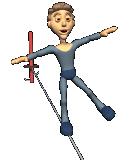
Monday, Mar. 29, 1937....Time Magazine....
Padding about uncertainly in the tumbled sawdust of the big cage, the last three or four lions responded to a cue from outside the bars, wheeled and sped toward the runway leading to their own cages. The crowd that packed Manhattan's cavernous Hippodrome one night last week was up in its seats, streaming toward the exits past the array of jabbering freaks in the lobby. And ducking into the wings with the last salvo of applause still drumming in his ears a small man, in a shirt and breeches that had once been spotless white, shouldered through a clutter of clowns, girls, circus hands and hangers-on, scurried up a spiral staircase to his dressing-room. He was streaked and spattered with muck from head to foot. Sweat trickled down his nose and cheeks, dripped from his chin. As he collapsed into a chair while an attendant pulled off the dusty boots, Clyde Beatty, the most celebrated trainer of lions and tigers in the world and part owner of the newest and most extraordinary U. S. circus, honestly sighed: "It's good to sit down!"
Clyde Beatty was thankful that he had got through the trying first day of a new season without a scratch for himself or a catfight among his 40 surly charges. To show business, however, the first day's two performances of the Cole Bros.-Clyde Beatty Circus marked a more important accomplishment, one which old John Ringling, last of the seven brothers, vowed he would never see but which he did not see only because he died last December. John Ringling was accustomed to open his season every year in Manhattan's Madison Square Garden with no rival in sight. His show had done so ever since 1909, three years after the Ringling and Barnum & Bailey outfits joined forces. With Ringling Bros, and Barnum & Bailey still in Florida winter quarters last week, this tradition was shattered when Cole Bros.-Clyde Beatty moved into the Hippodrome, became the first important tent show in a generation to challenge "The Greatest Show on Earth" not only by playing New York, hitherto practically a Ringling monopoly, but playing it before Ringling got there, and playing it under a "permanent top" (a building as distinguished from a tent).
Colossus. The last circus that tried to slide into Manhattan under the Ringling shadow was Sells-Floto. "Mr. John" stifled this competition in a characteristic fashion.
He bought up not only Sells-Floto but the other four circuses—Hagenbeck-Wallace, John Robinson, Sparks, Al G. Barnes— grouped with Sells-Floto in American Circus Corp. The property comprised 150 railroad cars, 2,000 animals, 4,500 people.
That was in the annus mirabilis 1929.
Independent— One ultimate effect of Depression on the circus business was that John Ringling eventually lost control of his shows. Unable to meet interest on a $1,700,000 loan, he was forced to turn over most of his assets to New York bankers. Another important result of Depression was to disgust Clyde Beatty, who had built his cat act into the world's most sensational one-man spectacle during the lean years, with the miserably disproportionate $100 a week salary his friends whisper he was getting from Ringling in 1934. Since there was no other circus to offer him more, Clyde Beatty decided to have his own circus. The 1935 season found Ringling without its standout attraction and it found Clyde Beatty starting an independent 200-town tour of his own. He had made some money from book royalties (The Big Cage), more in Hollywood from two motion pictures (The Big Cage, The Lost Jungle). So he and two other Ringling malcontents—Jess Adkins, long-time manager of Hagenbeck-Wallace, and Zack Terrell, longtime manager of Sells-Floto—had pooled their resources, scraped up a half-dozen backers and built a circus around Beatty's hair-raising cat act. The Cole Bros, name, an old and respected one in the circus world but dormant since the last Cole brother died in 1904, had been bought from the Toronto heirs of the family. For two years the new show toured the Midwest, fared well, stayed out of Manhattan.
Good times were returning. Last year the show was reported to have made $250,000 (of which Beatty received $40,000) and to have cut seriously into revived Ring-lings' business.
The Show— Except for a few great flash acts like Beatty, Con Colleano on the high wire or Ringlings' late great Aerialist Lillian Leitzel, one circus, at least to adults, is pretty much like another. One after another last week in the Hippodrome, which the musicomedy-circus Jumbo remodeled so that it ideally accommodates a condensed circus, 29 Cole Bros. -Beatty "displays" followed in fairly rapid, fairly unimpressive, succession, led off by "a magnificent and kaleidoscopic inaugural pageant participated in by hundreds of men, women, horses, elephants, yaks and beasts of the forest and jungle." Shiny seals balanced spinning balls on their moist noses, snapped up gobs of fish, barked lugubriously, played unrecognizable tunes by blowing into horns through their nostrils. One of the Picchiannis landed expertly in a chair after a triple somer sault from a teeterboard. Trainer Jorgen M. Christiansen put a troop of 24 fawn Colored horses through a series of maneuvers. "The Great Gretonas," like Ringlings' daring Wallendas, rode bicycles on a high-wire 45 ft. above the ring.
No. 29— With the 29th and last "display," the Cole Bros.-Clyde Beatty Circus stepped up into another class altogether A rising curtain disclosed a steel cage, 32 ft. in diameter, with a web of netting guarding the top. The lights were lowered a sound like thunder rumbled and syn thetic lightning glimmered. A big, heavy maned lion loped from the runway into the cage, slithered along an upward-sloping row of pedestals until he was crouched on the highest one. Two tigers came in and took their places beside him. Ten or twelve more beasts entered. While some of these were still milling around on the cage floor, Clyde Beatty, holding a blank-loaded pistol and a steel-bolted chair in his left hand and a whip in his right jumped into the cage, slapped the gate shut behind, pranced, crouched, cracked his whip. A lion made a tentative lunge at him. The pistol barked, the chair legs blocked the thrust of the paw, and the beast took his place. More cats ran in—a batch of lions, a batch of tigers, a batch of lions—keeping their heads and shoulders low to avoid cuffs from the others. Crack, Crack! Crack ! The whiplash exploded like a bunch of firecrackers until all the animals were pedestaled—25 lions and lionesses, 15 tigers and tigresses. A tiger with ominously writhing tail left its post, slunk toward the small figure in white. Beatty put his head down almost to the sawdust, pretended to be staring the animal into submission. Actually he was giving invisible "cues." The tiger bellied down, backed slowly away.
Darting, posing, shooting, the trainer made a bevy of his charges change pedestals. He fought off a lion that seemed to have pinned him against the bars. Every now and then a lion took a swipe at a tiger—or vice versa. Then the whiplash flicked over. The trainer swaggered up to a pedestaled tiger, thrust the chair at its open jaws. The animal knocked the chair aside. Soon the same tiger was obediently rolling itself along on top of a large cylinder. The trainer next made a lion sit up with its paws upraised like a begging dog's. Finally he made a tiger whirl round .& round like an animal obsessed. When he had cued most of the 40 beasts from their pedestals and driven them out the runway, came the great climax to the act.
Beatty made a dash for the gate. One of the remaining lions streaked after him, crashed against the gate just as Beatty, slipping outside, shut it in his face.
Tooth & Claw— The Beatty cat act is so thoroughly dramatized and "hoked up" to get the last tingling thrill from the most distant customer, that the skeptical are likely to be unaware of the act's real dangers. The lunges, feints and sham attacks of his beasts help make it a magnificent feat of showmanship, but they are not what Beatty worries about. Lions hate tigers and tigers hate lions, and in this atmosphere of hate the unexpected is always on the verge of happening. Beatty started mixing lions and tigers of both sexes in 1926 after a wise old "cat man" told him the old one-species, one-sex acts would not much longer satisfy a surfeited public. In 1928 his act contained 32 assorted cats, an unprecedented number. When he moved up to Ringlings' main how two years later he added eight more.
In such company Beatty cannot hope to prevent fights, is satisfied if he breaks them up without a killing or serious injury. He has had his arm chewed by a tigress, lis nose and forehead ripped open by a leopard, but his worst experience came after a big lion named Nero knocked him down and bit his leg. Jungle fever and gangrene set in and Beatty spent ten weeks in bed, almost died.
Altogether Beatty has lost 18 tigers, two lions in fights. Replacements cost him $500 or more and he values cats which have been through his step-by-step training course at $5,000 up. First step is to familiarize a "freshman" with the barred arena, make him understand thoroughly that Beatty is the Boss. He may spend weeks persuading the animal to go right or left after entering the cage, more weeks to elect and mount a pedestal. "Advanced trickology" is a matter of subtle, wordless cues, endlessly repeated. Lions and tigers cannot be instructed by pushing them around. Courage and showmanship avail a trainer little if he has not the almost telepathic knack of making his beasts understand what he wants.
Beatty strongly prefers jungle-born to cage-born cats. Three-quarters of this year's troupe were captured in the wilds. His reason for this preference is that animals familiar to man from birth are spoiled. As his good friend and collaborator Edward Anthony paraphrased his feelings in The Big Cage: "Cubs born in captivity simply do not have a chance. Their cuteness is their undoing. . . . Our civilization places too high a valuation on the cute and the cunning. There is nothing more characterless than a spoiled lion or tiger cub. . . ."
Clyde Raymond Beatty (pronounced Baity) is 31, 5 ft. 5½in. tall, weighs 145 lb., has enormously muscular forearms. He was born in Ohio and speaks pure Chillicothe (a tiger is a "tagger"). As soon as he finished high school he started training domestic animals in his backyard, got his professional start with a bear act. Soon he was mixing bears, lions and leopards. He never smokes or drinks hard liquor, sometimes quaffs beer. His only recreation is golf. His cats are fed—not by him—once a day, 18 to 20 lb. of prime beef after the afternoon performance. His own big meal of the day he consumes after the night show.
He has a small daughter by his first marriage. His second wife is a blue-eyed onetime circus aerialist named Harriet Evans, whom he persuaded to quit because he was afraid she would fall.
Away from the barred arena, Clyde Beatty is mild, friendly, unostentatious, likable. But he is a showman and he is on top. After the first two performances last week, convinced that New Yorkers are too blase to wait patiently for his act through the other 28 "displays," he conferred with his partners, had his act spotted immediately after the intermission. "After all," the world's greatest cat man blandly observed, "most of 'em must come here to see my act. It was just too long for 'em to set there."
Sunday, February 22, 2009
Cat Man
Subscribe to:
Post Comments (Atom)















0 comments:
Post a Comment